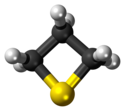| |||
| Names | |||
|---|---|---|---|
| Preferred IUPAC name Thietane | |||
| Systematic IUPAC name Thiacyclobutane | |||
| Other names Trimethylene sulfide | |||
| Identifiers | |||
| |||
3D model (JSmol) | |||
| 102383 | |||
| ChEBI | |||
| ChemSpider | |||
| ECHA InfoCard | 100.005.469 | ||
| EC Number |
| ||
PubChem CID | |||
| UNII | |||
| UN number | 1993 | ||
CompTox Dashboard (EPA) | |||
| |||
| |||
| Properties | |||
| C3H6S | |||
| Molar mass | 74.14 g·mol−1 | ||
| Appearance | Colourless liquid | ||
| Odor | Sulfurous | ||
| Density | 1.028 g cm−3 | ||
| Boiling point | 94 to 95 °C (201 to 203 °F; 367 to 368 K) | ||
| Hazards | |||
| GHS labelling: | |||
  | |||
| Danger | |||
| H225, H302 | |||
| P210 | |||
| NFPA 704 (fire diamond) | |||
| Flash point | −11(9) °C | ||
| Related compounds | |||
Other anions | Oxetane, Azetidine, Phosphetane | ||
Related compounds | Thiirane, Dithietane, Tetrahydrothiophene, Thiane, Thiepane, Thiocane, Thionane | ||
Except where otherwise noted, data are given for materials in their standard state (at 25 °C [77 °F], 100 kPa). | |||
Thietane is a heterocyclic compound containing a saturated four-membered ring with three carbon atoms and one sulfur atom. [1] [2] Some derivatives are of interest as drugs. [3]
Contents
Thietane, and its derivative 2-propylthietane, are strong-smelling mouse alarm pheromones and predator scent analogues. [4] [5] Both the mouse and human olfactory receptors MOR244-3 and OR2T11, respectively, were found to respond to thietane in the presence of copper. [6]



